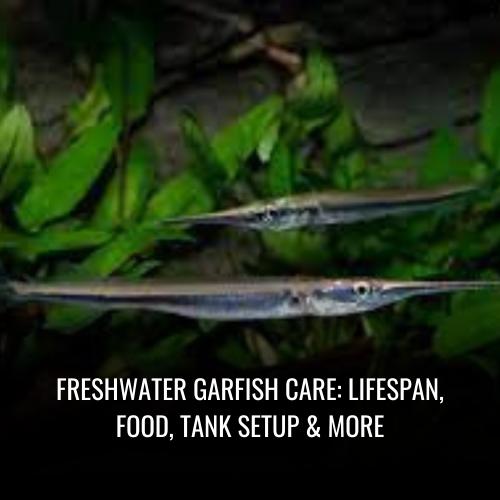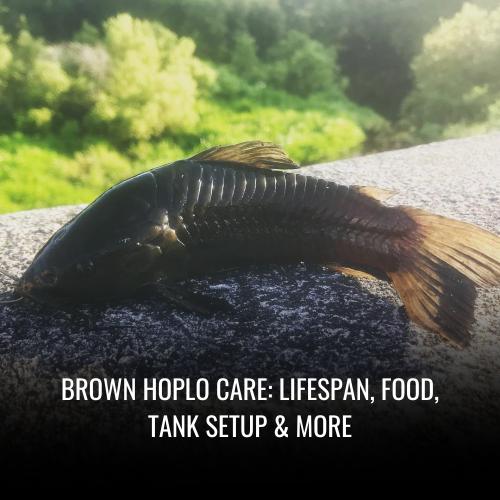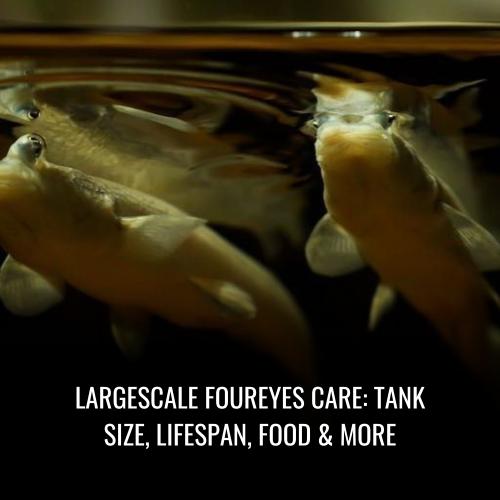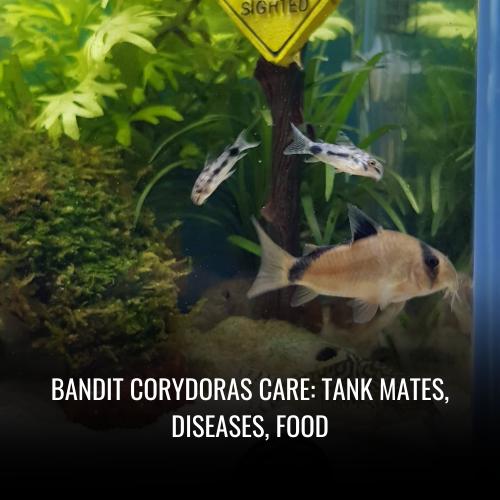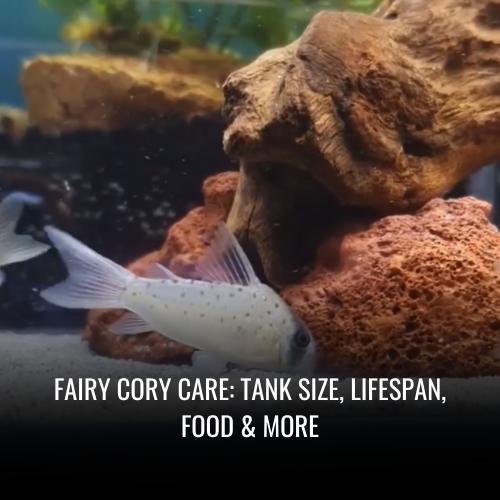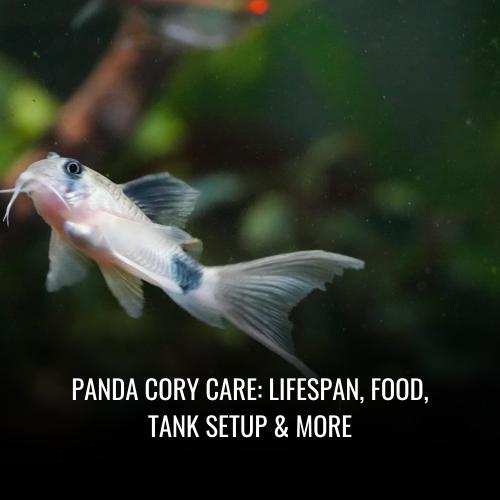Red eyed characin Care: Diseases, Tank Setup, Food & More
This post contains affiliate links. As an Amazon Associate, we earn from qualifying purchases.
The Red-eyed characin, also known as the African Red-eyed Tetra or Yellowhead Characin, is an attractive community fish hailing from the freshwater streams and rivers of Africa, mainly found in the Niger and Ogun river systems. They are appreciated for their vibrant red eyes and energetic swimming behavior, requiring plenty of swimming space. Here’s a profile on this fascinating species:
| Characteristic | Detail |
|---|---|
| Scientific name | Arnoldichthys spilopterus |
| Common names | Red-eyed Characin, African Red-eyed Tetra |
| Family | Alestidae |
| Usual size in tanks | 2.5-3 inches (6-7.5 cm) |
| Recommended pH range | 6.0 – 7.5 |
| Recommended water hardness (dGH) | 4 – 18° |
| Recommended temperature | 73.4 – 80.6°F (23 – 27°C) |
| Reproduction | Egg-layer |
| Origin | Western Africa |
| Temperament to own species | Peaceful |
| Temperament toward other species | Generally peaceful |
| Usual place in the tank | Mid to top level |
| Lifespan | 5 years |
| Tank size requirement | 30 gallons (114 liters) or larger |
| Filtration system | Gentle water flow with regular water changes |
| Sexual dimorphism | Mature females fuller bodied |
| Substrate cleaning | Organic matter contributes to their diet |
This community fish does well in a set-up that simulates their natural habitat with soft, slightly acidic water and enjoys a variety of foods including quality flake food, brine shrimp, and frozen foods. To breed, a separate breeding tank can enhance success, with the mature females displaying fuller bodies when ready to spawn. Regular care of water quality, alongside proper feeding, will ensure a thriving environment for the Red-eyed characin.
Scientific Name
The specific scientific name Petersius spilopterus distinguishes it from similar species, providing a precise taxonomy used extensively within the fishkeeping community. It’s essential to acknowledge this taxonomical distinction to appreciate the unique characteristics that define the Red Eyed Characin and to maintain clarity in its care and breeding practices. The dual naming system—a universal scientific name accompanied by various common names—caters to a broader audience and embodies the fish’s multifaceted presence in different cultural contexts.
Scientific Naming Profile:
| Taxonomical Marker | Value |
|---|---|
| Scientific Name | Petersius spilopterus |
| Common Names | Niger Tetra, Red Eyed Tetra, African Red-Eyed Characin |
| Importance of Naming | Precise identification, effective communication |
| Identification | Differentiation from similar species |
| Use in Community | Clarity for hobbyists, breeders, researchers |
Adhering to its scientific name is not just a formality but a tool for fostering a standardized and knowledgeable fishkeeping environment.
Average Size
The Red Eyed Characin, also affectionately known as the African Red-eyed Tetra, boasts a modest size, making it a manageable and desirable addition to many home aquariums. In captivity, these fish typically range from 5 to 7 centimeters (2 to 2.75 inches) in length, striking a balance between visibility and modesty in tank size requirements. However, in the wild, they often attain a slightly larger stature, growing up to about 8 centimeters (3.15 inches). Their streamlined body and slender form are indicative of their efficiency in swimming through their native environments.
Juvenile Red Eyed Characins start off small at about 1.5 centimeters (0.6 inches), gradually growing to reach their full potential size while under considerate care in aquariums. Genetic factors, as well as environmental factors like diet and water quality, can influence their growth, leading to some individual size variation among the population.
| Environment | Average Size |
|---|---|
| Captivity | 5 – 7 cm (2 – 2.75 inches) |
| Wild | Up to 8 cm (3.15 inches) |
A well-maintained aquarium with suitable conditions can closely mirror their natural habitats, promoting healthy growth. Owners should note that the size of their aquatic pet is a good indicator of overall well-being.
Lifespan
With appropriate care, the Red Eyed Characin, also recognized as the African Red-eyed Tetra or Arnoldichthys spilopterus, can grace a home aquarium for 5 to 10 years. Their longevity is not just a stroke of luck; it is largely dictated by the conditions in which they live and the level of care they receive.
Suitable aquarium conditions that mirror the natural habitat of the Red Eyed Characin, such as gentle water flow, soft, acidic water, and plenty of swimming space, play a vital role in extending their lifespan. Regular water changes and maintaining high water quality help mimic the clean rivers of their African homelands like the Niger and Ogun rivers, promoting both physical health and psychological well-being.
A balanced diet, encompassing high-quality flake food and varied sources such as brine shrimp and other frozen foods, provides the nourishment these characins need to thrive. Moreover, creating a stress-free environment by housing them with compatible community fish and ensuring enough organic matter for a natural setting can lead to a full and healthy life.
To fight off diseases – a common cause of decreased lifespan – adopting quarantine procedures for new tank mates and promptly addressing any signs of illness is crucial.
| Factors Influencing Lifespan | Recommendations |
|---|---|
| Tank Environment & Size | Ample space and conditions mimicking natural habitat |
| Water Quality | Frequent changes and proper parameters maintenance |
| Diet | Balanced with quality flake food and variety |
| Stress Levels | Compatible tank mates and a peaceful setting |
| Disease Prevention & Treatment | Vigilant quarantine procedures and prompt care for ailments |
By adhering to these care principles, enthusiasts can ensure these captivating fish live out their full potential lifespan.
Natural Habitat
African Red-eyed Tetras, indigenous to Africa’s Ogun and lower Niger River systems, dwell in tannin-rich streams and serene rivers. Their environment is a complex mosaic of clear, slightly acidic water, and the organic matter littered riverbed provides a tranquil refuge. However, these vibrant fish are currently at risk due to their limited distribution and the ongoing destruction of their habitats, underscoring the necessity of conservation efforts.
In contrast, Red-eyed Tetras are also found in South America’s pristine waters, from Paraguay to Bolivia, Peru, and Brazil. Here, they navigate the clean currents in schools, sourcing their diet from an abundance of worms, crustaceans, and insects.
Overview of Natural Habitats:
| Region | Water Characteristics | Diet | Conservation Status |
|---|---|---|---|
| Africa (Niger and Ogun rivers) | Tannin-stained, acidic | Organic riverbed matter | At risk due to habitat degradation |
| South America (Paraguay to Brazil) | Clear rivers | Worms, crustaceans, and insects | – |
This table summarizes the critical contrasts between their African origins and South American habitats. It highlights the primary threats they face in their natural environments.
Appearance
The Red Eyed Characin, or African Red-eyed Tetra, captivates aquarists with its stunning physical attributes. Sporting an average length between 2 to 2.5 inches (5 to 6.5 cm), its streamlined, elongated silhouette glimmers with a silvery sheen. But the most arresting feature is undoubtedly its vivid red eyes, evoking a sense of aquatic allure.
A closer examination reveals the intricate beauty of their bodies: dark spots and stripes adorn the lateral line, enhancing their visual appeal. Sexual dimorphism is evident in this species. The table below summarizes the differences between males and females:
| Sex | Color Intensity | Body Shape |
|---|---|---|
| Males | More intense red | Slimmer |
| Females | Less intense red | Rounder |
Males boast a richer red hue and present a svelte form, while females are generally more robust. This chromatic dynamism and the peaceful temperament of Red Eyed Characins make them prized members of community fish tanks, thriving best among congenial companions. With adequate care in an appropriate environment, these characins can enjoy a healthy lifespan of around 5 years, continually gracing their aquatic domain with their enchanting presence.
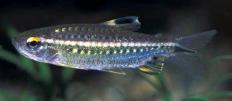
Behavior & Temperament
The Red Eyed Characin (Arnoldichthys spilopterus) is often celebrated among aquarists for its docile nature that enriches the diverse tapestry of a community aquarium. Gliding gracefully through the water, these fish exude tranquility and are known for their fondness of shoaling in the upper and middle layers of the water column. Sociable and non-confrontational, Red Eyed Characins are ideal for creating a peaceful aquatic tableau.
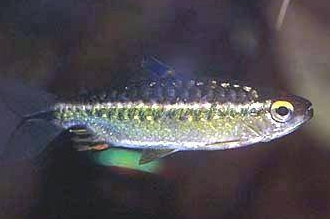
Are Red eyed characin Fin Nippers?
One question that arises when selecting fish for a community tank is whether the newcomers are prone to fin nipping. Red Eyed Characins are well-regarded for their gentle demeanor. They are not known to be fin nippers and coexist serenely with a multitude of other species. Belonging to the Alestidae family, these fish tend to prioritize their social interactions over any disruptive behaviors such as fin nipping, making them harmonious tank mates.
Is Red eyed characin Aggressive To Each Other & Other Fish?
Aggression in an aquarium can lead to stress, injury, and even mortality among fish, disrupting the tranquility of the environment. However, Red Eyed Characins are known for their peaceful behavior toward one another and other aquatic companions. Their tendency to occupy the top levels of the tank minimizes competitive encounters with other species, ensuring a serene habitat for all. The African rivers from which they originate, such as the Niger and Ogun, have shaped them to coexist amicably, a trait that translates well to captivity. Thus, they represent a non-aggressive choice for a community setting.
Are Red eyed characin Friendly To Each Other & Other Fish?
The amiable nature of the Red Eyed Characin makes it a precious jewel in the crown of community aquariums. They are not only peaceful towards their own species but exhibit a welcoming demeanor towards a variety of other fish. This affable behavior is mirrored in how they interact with non-threatening tank mates, fostering a convivial environment in the aquarium. Such friendliness ensures they are a joy to keep and observe, particularly when they form enchanting schooling displays in the aquarium.
Are Red eyed characin Schooling Fish?
In the wild, the Red Eyed Characin is a consummate team player, often found schooling in the placid waters of their native rivers. This schooling behavior is both a survival tactic and a natural spectacle. In the confines of an aquarium, it’s recommended to maintain these Characins in groups to uphold this intrinsic part of their behavior. A school of at least ten individuals translates into an enthralling sight, with energetic swimming patterns and a flash of vibrant colors.
Can You Have Just One Red eyed characin In The Tank?
Loneliness can take a toll on the social Red Eyed Characin, leading to stress and abnormal behaviors. It is not advisable to house a solitary member of this species in a tank as it detracts from its natural inclination for group living. Providing a group ensures these fish can engage in their natural schooling behavior, maintain their wellbeing, and exhibit the full extent of their exuberance for the best aquarium experience.
Do Red Eyed Characin Need To Be In Groups?
These social creatures display their most splendid colors and characteristics when they swim alongside their conspecifics. It is best practice to keep Red Eyed Characins in groups, as it imitates their natural schooling propensity, thereby fostering a secure and stimulating atmosphere.
A group of at least six is often recommended, but larger schools are favored to fully capture their captivating social dynamics and promote a healthier, more animated environment within the aquarium.
Food & Diet
The dietary habits of the Red Eyed Characin (Arnoldichthys spilopterus) reflect their omnivorous nature, as they require a mix of both plant matter and meaty foods to thrive. In their natural environment of the Niger and Ogun rivers in Africa, they typically dine on a variety of small invertebrates and organic matter, which provides them with the essential nutrients needed for their vibrant coloration and overall health.

Does Red eyed characin Eat Algae?
Algae is not a major component in the diet of Red Eyed Characins. Their carnivorous leanings in the wild suggest a preference for a diet rich in small invertebrates rather than algae. Even though incidental ingestion may occur during feeding, aquarists should not regard algae as a significant or necessary part of their nutritional profile. To promote the well-being of these fish, it’s recommended to supply them with an assortment of protein-rich options such as quality flake food, brine shrimp, and bloodworms.
Does Red eyed characin Eat Shrimp?
Red Eyed Characins may partake in eating small live or frozen shrimp, an element of their varied diet in their native rivers. Aquarists should ensure these fish receive a well-rounded diet, and when shrimp are included, they should be an appropriate size to prevent predation issues with smaller shrimp species. To keep a balanced diet, include high-quality flake foods and other protein sources alongside live or frozen shrimp offerings.
Do Red eyed characin Eat Bloodworms?
Bloodworms are a dietary delight for Red Eyed Characins. Both in the wild and in captivity, these larvae of midge flies are a nutritious and favored food source. When bloodworms are served, they elicit the fish’s natural foraging behavior, eagerly consuming and deriving health benefits from them. Their inclusion in the diet aids in maintaining the natural feeding behaviors of Red Eyed Characins and ensures they receive a rich source of protein.
Do Red eyed characin Eat Mosquito Larvae?
Red Eyed Characins in their natural habitat would frequently feed on mosquito larvae, which provide nourishment in the form of protein and other essential nutrients. In a home aquarium, these larvae can be offered as live or frozen food to benefit the health and diet of Red Eyed Characins. Such treats not only satisfy their natural predatory instincts but also enhance their well-being in the controlled setting of a tank.
Do Red eyed characin Eat Planaria?
While planaria might be present in an aquarium setup, they are not typically part of the Red Eyed Characin’s diet. The fish’s preference lies with small crustaceans and insect larvae as they are carnivorous by nature. Therefore, planaria do not make up a significant or desired part of their sustenance, and these characins are not known to actively search for planaria for food.
Do Red eyed characin Eat Plants?
Red Eyed Characins are primarily meat-eaters and plant matter does not make up a substantial part of their diet. Although they may sometimes nibble on tender aquatic plants, they are not considered to have a high impact as plant eaters. To discourage any plant nibbling tendencies, a varied diet rich in protein such as brine shrimp, bloodworms, and quality flake food should be consistently provided. With plenty of their favored foods available, Red Eyed Characins generally show little interest in consuming live plants in an aquarium.
These feeding habits underscore the necessity of offering a diet that mimics the natural food sources of Red Eyed Characins to maintain their health and vibrancy within the aquarium environment. Regular offerings of frozen foods, freeze-dried treats, as well as quality flake food, support their well-rounded diet and contribute to a thriving life in captivity.
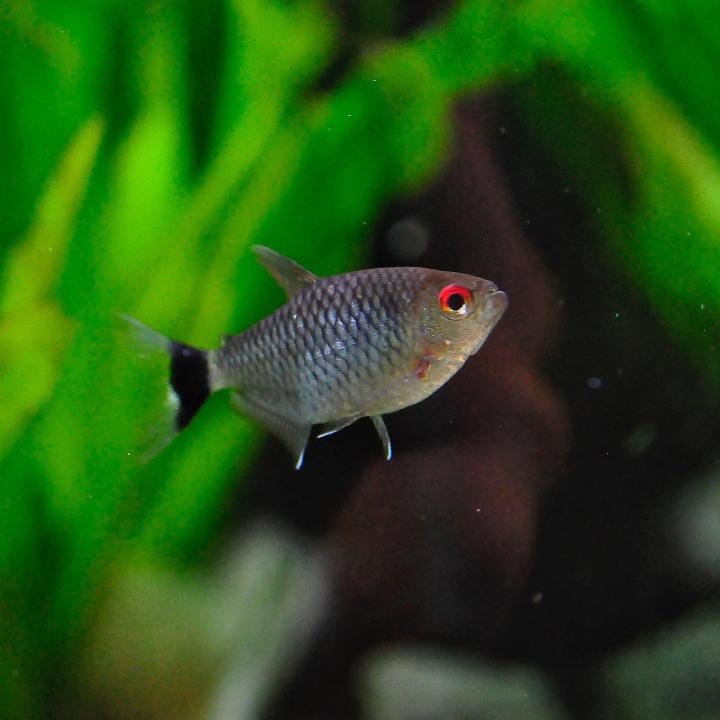
Sexing: Male vs Female
Determining the sex of Red Eyed Characins can be straightforward if one knows what to look for. The males of the species boast more pronounced hues, especially apparent in the yellow or orange anal fin, which is further embellished with five dark bands and a distinct dark trim. Contrarily, females exhibit dark spots on their own anal fins and lack the male’s vivid coloring.
Observing the abdomen of the fish provides another hint—females possess a more rounded belly, indicative of a mature female. This feature can be particularly helpful during reproductive periods when the distinction becomes more pronounced.
The anal fin’s shape and coloration serve as the principal differentiators between the sexes:
- Males: Bright, colorful anal fin with five dark bands.
- Females: Anal fin with dark spots and less vibrant color.
Here’s a table for quick reference:
| Sex | Anal Fin Coloration | Anal Fin Pattern | Belly Shape |
|---|---|---|---|
| Male | Yellow or orange | Five dark bands | Standard |
| Female | Less colorful | Dark spots present | Rounded (mature) |
Males tend to have more eye-catching attributes, while females are recognized by their subdued fin patterns and fuller stomachs.
Red eyed characin Tank Mates
Red Eyed Characins, also known as African Red-eyed Tetras or Yellowhead Tetras, are the epitome of peace in a community aquarium. To see them truly flourish, group them with at least five of their kind. This amplifies their shoaling instinct and helps them thrive by minimizing stress.
Their tank mates should share their tranquil demeanor. Small, peaceful fish such as tetras, rasboras, and non-aggressive dwarf cichlids are ideal companions. These fish respect each other’s space and contribute to a harmonious habitat.
Bottom dwellers like Corydoras are an excellent choice — they keep to themselves, scouring the aquarium floor, while the Red Eyed Characins prefer the mid to upper levels, ensuring all areas of tank real estate are peacefully shared.
Aggressive fish are a definite no; Red Eyed Characins are too timid for a turbulent life among fin-nippers or bully fish. Large predators are equally unsuitable, as their size and nature pose a threat to these serene swimmers.
Ideal Tank Mates for Red Eyed Characins:
- Tetras
- Rasboras
- Peaceful Dwarf Cichlids
- Corydoras Catfish
Remember the golden rule: peace breeds peace. Thus, choosing tank mates for the Red Eyed Characins should be done with their gentle nature in mind.
Aquarium Setup
When setting up an aquarium for Red Eyed Characin, also known as African Red-eyed Tetra or Yellowhead Characin, there are several key factors to consider to emulate their natural habitat and ensure their well-being. This begins with selecting the appropriate size of the tank, fine-tuning water parameters, establishing a suitable filtration system, and providing the right lighting conditions. An ideal setup not only promotes the health and happiness of these peaceful community fish but also enhances their striking appearance, with their vibrant red eyes and yellow-marked faces being a captivating sight against the backdrop of a well-maintained tank.
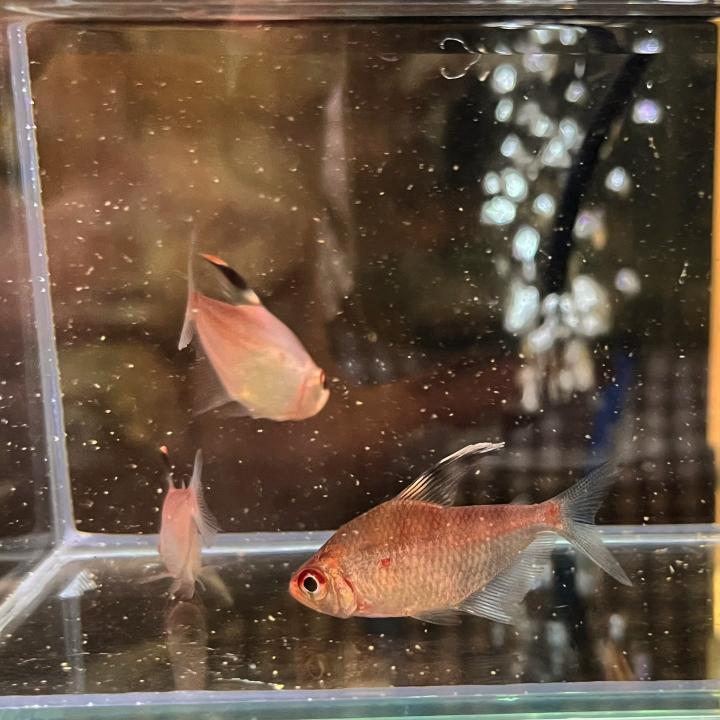
Ideal Tank Size
The perfect aquatic home for Red Eyed Characin is a spacious tank that provides plenty of swimming space to support their active and social nature. A 20-gallon tank is the minimum recommended size for a small group of 5 to 6 fish, but if you’re looking to keep a larger shoal or wish to house them with a variety of community fish, consider opting for a 30-gallon tank or larger. This additional space will ensure each Characin has enough room to exhibit its natural behaviors and maintain the pecking order without incident.
A longer tank, approximately 30 inches in length, is preferable over a taller one since Red Eyed Characins enjoy a wide horizontal space to roam. This arrangement provides an ideal swimming arena for these agile swimmers and mimics the spread of their native rivers. Furthermore, it allows aquarists to design a diverse landscape with areas for planting and decoration that enhance the tank’s ecological balance.
Ideal Water Parameters
Crafting the right water parameters is crucial in replicating the soft, acidic waters Red Eyed Characins are accustomed to in the wild. An optimal temperature range for these fish is from 22 to 26 degrees Celsius (71.6 to 78.8 degrees Fahrenheit). These characins prefer a pH balance between 6.0 to 7.5, indicative of mildly acidic to neutral water. As they stem from environments with generous amounts of leaf litter, they are suited to soft to moderately hard water, with a general hardness (GH) of 5 to 20 degrees and a carbonate hardness (KH) of 4 to 8 degrees.
For the well-being of your fish, keep an eye on the total dissolved solids (TDS), which should fall between 18 to 268 ppm. Precise control of temperature, pH, and water hardness is fundamental to providing Red Eyed Characins with an optimal habitat, which reinforces their health, color vibrancy, and breeding propensity.
Filtration
Red Eyed Characins are sensitive to fluctuations in water quality, which makes an effective filtration system a necessary component of their aquarium setup. An efficient filter holds the key to maintaining pristine water conditions, and for these characins, a system that produces a gentle water flow is most suitable. A filtration setup that includes mechanical, biological, and chemical mediums will be most beneficial in ensuring clean water free of harmful compounds.
Regular water changes, amounting to 25 to 50% biweekly, are also essential for preserving water quality, complementing the filtration by removing excess organic matter, nitrates, and phosphates. A combination of quality filtration and diligent maintenance routine will go a long way in creating a healthy environment for these community aquarium staples.
Lighting
The Red Eyed Characin’s natural environment is often dimly lit, with soft rays filtering through the dense canopy of the African waterways. Mimicking these conditions can be achieved with moderate lighting in the home aquarium. Aim for a lighting duration of about 8 to 12 hours per day to cater to the needs of aquatic plants without overexposing the fish.
Opt for full-spectrum bulbs or LED lights to provide the range of wavelengths required for plant photosynthesis, ensuring that your aquatic plants remain vibrant and healthy. Moreover, installing floating plants can replicate the shaded conditions of the Red Eyed Characin’s natural surroundings while also helping to control light levels for algae management.
Periodic maintenance of the lighting system, including cleaning and replacing bulbs when necessary, is essential for consistent light quality. The lighting fixtures should be adjustable to cater to the depth of the tank and various plant growth requirements, thus creating an optimal environment for all inhabitants of the aquarium.
Common Possible Diseases & prevention
Red Eye Tetras are considered hardy fish, but they can still fall victim to common aquatic diseases. With proper care, these risks can be minimized.
Disease Prevention:
- Quarantine
- new arrivals including fish, plants, and décor to prevent disease introduction.
- Thorough Cleaning of new additions to the aquarium helps eliminate pathogens.
- Observation is key; monitor fish regularly for early signs of illness.
- Balanced Diet and a natural habitat in the aquarium can reduce stress, enhancing the fish’s immune system.
Common Diseases:
- Skin Flukes: Parasites that affect the skin.
- Ichthyobodo Infection: Also known as “Costia,” causing lethargy and loss of appetite.
- Bacterial Infections: Can manifest as fin rot or ulcers.
- Parasitic Infestations: Such as ich or “white spot disease.”
Early Detection: Look for symptoms like erratic swimming, loss of color, or clamped fins for prompt treatment.
Maintaining a well-regulated aquarium and a watchful eye are the best ways to ensure your Red Eye Tetras stay healthy and vibrant. Regular maintenance and adequate water quality will support their resilience against disease.
Breeding Red eyed characin In Aquarium
Breeding Red-eyed Characin successfully in captivity requires meticulous preparation and attention to their environment. To closely mimic their native African Niger and Ogun rivers, a separate breeding tank should be set up. This tank needs to have a gentle water flow and should maintain slightly acidic water, reflecting their natural habitat.
Breeding Tank Essentials:
- Acidic Water Conditions: Slightly acidic to match their natural habitat.
- Gentle Water Flow: To simulate river currents.
- Fine-Leaved Plants: Provides a natural spawning substrate.
Once the environment is established, the breeding pair, recognized by Sexual Dimorphism where the mature female often displays a fuller body, can be introduced. Following spawning, it is imperative to remove the adults to prevent predation on the eggs.
Hatching occurs within 24-36 hours, revealing transparent fry with yolk sacs. Their initial diet should consist of live micro-foods such as rotifers or infusoria. As they grow, they can be weaned onto larger fare, including brine shrimp.
Key to Success:
- Fry Foods: Rotifers, infusoria, and then brine shrimp.
- Egg Safety: Remove adults post-spawning.
- Water Quality: Regular changes to maintain cleanliness and stability.
Careful management of the water quality through regular changes is crucial to raising healthy fry and ensuring the ongoing vitality of the species in your care.
Isthe Red eyed characin Easy To Keep?
Red Eyed Characin, known scientifically as Arnoldichthys spilopterus, are often recommended for amateur and advanced aquarists alike due to their adaptable and amiable nature. These fish showcase a degree of resilience in the face of various water conditions, with a flexible pH range of 6-8 and water hardness between 5-19°N, they can thrive in a diversity of aquatic environments. They prefer warm water, with the ideal temperature sitting cozily between 24-26°C (75.2-78.8°F), which aligns well with standard household aquarium temperatures.
Their compatibility extends beyond water parameters to their tankmates as well, as Red eyed characins typically dwell in the upper levels of an aquarium, showcasing their amiable nature by interacting peacefully with other species. This makes them especially suitable for community aquariums, where they add a dynamic element without causing disruption to other inhabitants. Furthermore, the ease with which they breed adds another layer of interest for enthusiasts, making Red eyed characins a rewarding choice for a home aquarium.
Are Red eyed characin Sensitive To Water Changes?
While the Red eyed characin can be deemed manageable in their care, their sensitivity to sudden alternations in water parameters, particularly temperature and pH, should not be overlooked. Rapid and unexpected shifts can induce stress, compromising their immune function and potentially leading to health issues. To safeguard their well-being, it’s imperative to maintain stable conditions within the recommended ranges for temperature, pH, and hardness. Notably, abrupt changes in water quality, like ammonia spikes or nitrate elevations, can detrimentally affect Red eyed characins. Vigilance in water quality monitoring and careful execution of changes during routine maintenance is essential to ensure a stress-free habitat for these delicate fish.
Are Red eyed characin Sensitive To Ammonia?
Red eyed characin are particularly sensitive to ammonia, which can induce stress, impede their respiratory function, and cause gill damage. Ammonia is a insidious threat that can weaken their immune system, leaving them vulnerable to a host of diseases and infections. In the presence of high ammonia levels, Red eyed characins might display telltale signs of discomfort, such as gasping for air at the surface or displaying irregular swimming patterns—a clear cry for a cleaner environment. Consistent water quality assessments and proper tank hygiene are indispensable measures in keeping ammonia levels in check to safeguard the health of Red eyed characins.
Are Red eyed characin Sensitive To Copper?
Emerging from the copper-sparse soft, acidic rivers of Africa, such as the Niger and Ogun, Red eyed characin hold a distinct intolerance to copper in their aquatic habitat. The slightest excess of this metal can disrupt critical water balance, eliciting stress and health complications in these serene fish. Any introduction of copper, often found in medications, algaecides, and additional aquarium supplements, requires cautious application, as these could introduce harmful concentrations into the tank environment. Ensuring a copper-free milieu through persistent water quality checks, coupled with the ,regular refreshment of the tank, becomes a cardinal rule for sustaining the health and contentment of Red eyed characins in captivity.

